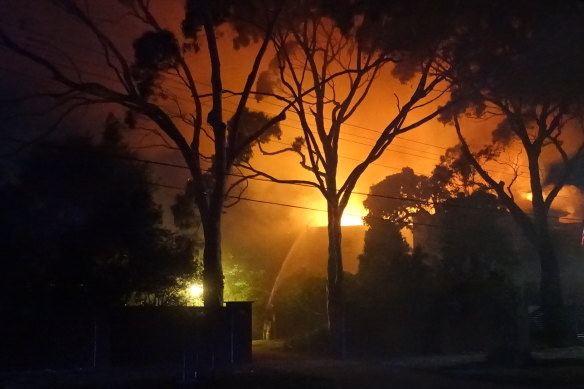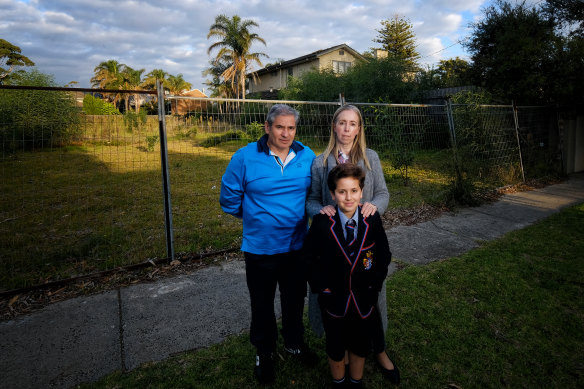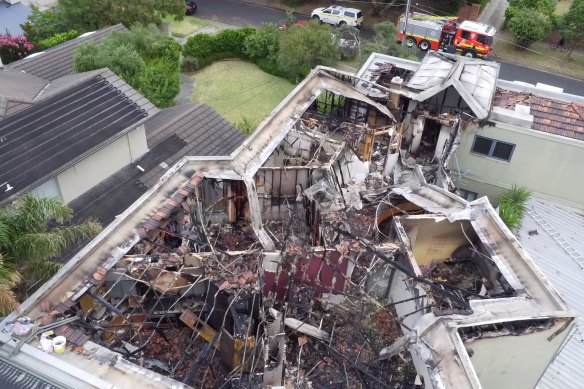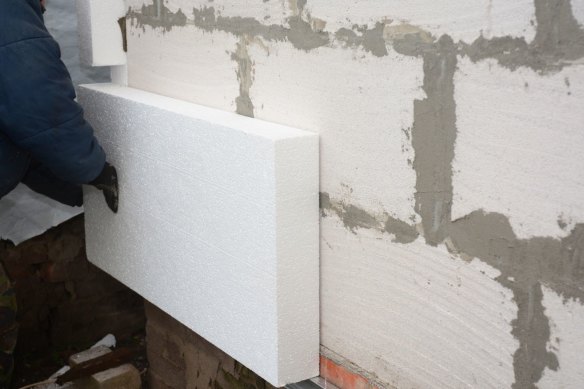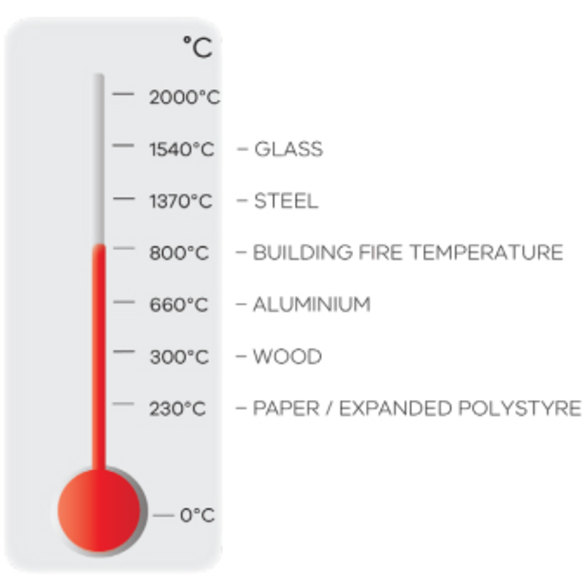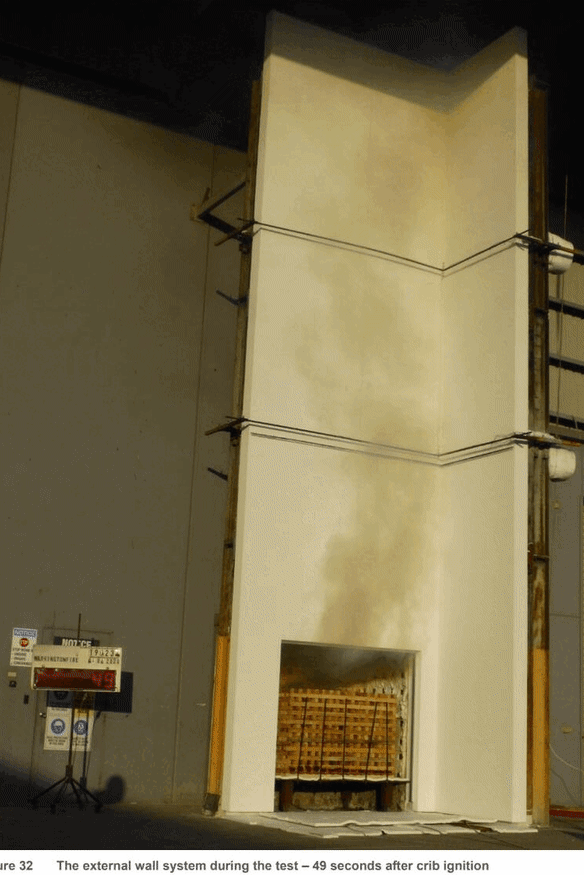By Simone Fox Koob and Chris Vedelago
Save articles for later
Add articles to your saved list and come back to them any time.
It didn’t take long for the house next door to burn.
As she helped her son brush his teeth one evening in early 2019, Melanie Francese saw a red glow outside the bathroom window. When she looked outside, flames were taking hold of the roof of her neighbour’s home.
Within minutes, her family were standing on the street, watching as fire engulfed the top storey.
Fire rips through a house in Beaumaris in February 2019.
More than four years on, the night is fresh in her mind.
“I just remember that intensity of it. Windows breaking and popping. Glass exploding and obviously a lot of noise from fire trucks,” she says.
An incident report conducted by the fire services in the weeks after the blaze would reveal that their neighbour’s home, a five-bedroom, two-storey house in Beaumaris in Melbourne’s upmarket south-east, was covered in a combustible cladding material called expanded polystyrene (EPS).
EPS is derived from petroleum and ignites at far lower temperatures than other building materials.
“When it burns, a kilogram of polystyrene will release more energy than a litre of petrol,” says a safety alert about the product issued several years ago by the Victorian Building Authority.
Angelo and Melanie Francese with son Patrick in front of the empty land next to their home in Beaumaris. Credit: Luis Ascui
Consumers will be most familiar with EPS as a packaging material for goods such as televisions and food, and the insulation inside portable coolers.
In the past two decades, EPS (which is often combined with a fire retardant when used in construction) has been used to build many homes and properties across the country because it is lightweight and energy-efficient. However, it burns hot and fast, and emits dangerous toxic fumes during a fire.
While EPS was banned for use on multistorey apartment buildings by the Victorian government in 2021, its use is unrestricted on detached homes and multistorey townhouse projects, and it is being used widely across Melbourne when building and renovating.
Several reports from Fire Rescue Victoria, obtained through freedom of information, have linked the material to at least eight incidents at homes – including the Beaumaris blaze – that occurred between 2016 and 2019 where fires were ignited, proved hard to control and contain, and caused worse than expected damage.
This has raised concerns among senior firefighters. A Fire Rescue Victoria fire safety inspector, who wished to remain anonymous to discuss the situation, says the standard response time for fire services to reach a structure fire is 7.7 minutes, but blazes featuring EPS can “fully involve” a home in five minutes.
“It’s not a building product, it’s a fuel source,” he says. “There’s no real understanding out there that people are effectively living inside a giant Esky with windows.”
‘Really nasty stuff’
In Beaumaris, the block next to Melanie Francese’s home now sits vacant.
After the blaze on the night of February 19, 2019, the house was uninhabitable and what was left was demolished. The family that had been renting it lost most of their possessions.
The owners of the home could not be reached by this masthead, and the renters did not want to comment.
A Metropolitan Fire Brigade (now Fire Services Victoria) risk report about the fire, carried out to raise awareness within firefighter ranks about the risks associated with combustible cladding, identified that the upper storey was constructed of EPS sheets screwed to timber frames.
The report said one of the residents was alerted to the fire after a popping noise was heard in some light fixtures on the ceiling of the upper floor. When they went to investigate, they found flames in the roof space.
The Beaumaris home after the blaze. Credit: Metropolitan Fire Brigade/Twitter
Fire crews were “confronted with intense fire through the roof of the house”, with conditions made more unpredictable by strong winds.
“The smoke from burning EPS is highly toxic. EPS fires produce characteristic black smoke,” the report says.
These are the kind of fires that have caused alarm among firefighters.
A Fire Rescue Victoria report, obtained by this masthead through freedom of information, was conducted in 2020 after a spate of fires that involved EPS.
“The fires are of particular note due to the relative short time interval between the fires and the extensive damage to the structures,” it reads.
In one fire, which took hold in a half-built home, the EPS ignited and melted away from its fixings, causing “intense pool fires”. Hot gasses rose on the underside of the timber roof, causing it to ignite.
In another, the EPS cladding melted away, leaving only the fixing screws on the face of the timber frame.
Fire Rescue Victoria said, in all the scenarios, the presence of EPS panels was likely to have accelerated fire spread.
It says the product has been found to burn quickly and poses an increased risk to occupants and responding firefighters.
It confirmed that its fire investigators had analysed the role EPS played in several significant fires over the past few years, and found it probably contributed to the speed at the which the fires burnt.
While it is not permitted in high-rise buildings due to these risks, even in low-risk buildings EPS can burn quickly and contribute to the size and spread of a fire, they said, adding it was important owners and renters were aware of what materials were used to build their homes.
Deputy Commissioner Costa Katsikis says Fire Rescue Victoria works with other relevant authorities to address the risks posed by combustible cladding, and will continue to analyse the risks posed by EPS in low-rise buildings.
Stephen Kip, an experienced fire safety engineer, says that while the number of house fires is not increasing, the fire damage is greater because of the way EPS burns.
Expanded polystyrene being used in construction. Credit: Expanded Polystyrene Australia
“There is a huge [occupational health and safety] issue for fire brigades now because burning polystyrene produces some really nasty stuff. And if you’re attending those fires and breathing that in once a week for 30 years, we don’t know what the effect of that will be,” he says.
“I can see the dilemma they’re in. They’ve got buildings with highly combustible materials that are also hazardous to firefighters. And they have a legal obligation to go to the site as a fire ground is a firefighters’ workplace.
“The fire brigade is in a really awkward position. It’s a really difficult time. And I think the government’s really unclear about what to do next.”
How did we get here?
Rules dictating what materials can be used to build external walls have existed for hundreds of years.
Australia’s earliest building regulations were modelled on Britain, where combustible walls and roofs were banned following the destruction wrought by the Great Fire of London in 1666.
Since then, building codes have been continually updated, changed and revised, with builders expected to meet an array of different standards.
Lightweight, highly energy-efficient and cheaper than traditional materials, EPS ticked many boxes for builders when it came onto the Australian market in the 1980s. It gained popularity in the building industry as external cladding, as it doesn’t rot or attract vermin like rats or termites.
Becher Townshend, the executive director of Expanded Polystyrene Australia, says EPS is regularly used in construction projects as insulation panels. He says the products used are safe, contain a fire retardant, comply with Australian standards, and when installed correctly are not an undue fire hazard.
“The products will burn when in contact with a flame, like any other organic building material such as wood, but collapses on itself and will extinguish when the flame source is removed,” he says.
An analysis of the cost of using three commonly used types of cladding to build a two-storey, three-bedroom home, prepared by Australian Institute of Quantity Surveyors fellow Jay Fernando for this masthead, found EPS was the cheapest by some margin.
The approximate cost for 180 square metres of EPS facade was $20,364, compared with $24,426 for Nasahi panels (made of aerated concrete) and $37,505 for cemental cladding.
But there are downsides. Apart from high flammability and concerns about its potential toxicity to firefighters, there have been issues with moisture ingress and condensation if it’s not installed properly.
Kip says he believes EPS is the second most common external cladding product in Australia for housing, after brick veneer. It is widely used not just because of its low cost, he says, but because it meets strict energy efficiency requirements set by governments.
“Builders changed from cement sheet to polystyrene because the government’s regulated high levels of energy efficiency that cement sheet or timber weatherboards couldn’t achieve,” he says.
“Building regulations used to be really simple and clear, they were about health, safety and amenity. But now we’ve drifted into more complex policy areas such as consumer protection, energy efficiency and disability access.
“And, frankly, we’ve got too many matters now that overlap and contradict each other and polystyrene cladding is one of them.”
Requirements for the energy efficiency of new builds are regularly introduced and refined. Last year, the Australian Building Codes Board was asked to update energy efficiency provisions for new residential buildings in its next edition of the National Construction Code.
In a report prepared by a consulting firm asked to assess the costs and benefits of proposed increases in energy efficiency requirements, key groups the Housing Industry Association and BlueScope Steel said one of the unintended consequences of the proposed changes was it could encourage the use of expanded polystyrene, increasing the fire risk of new housing.
A thermometer showing melting and ignition points.Credit: Victorian Building Authority
Concerns about the way EPS and other combustible cladding products have been installed have also been raised in successive reports that have scrutinised Australia’s building industry.
The landmark Shergold-Weir report completed in NSW in 2018 found building practitioners across the country did not have a sufficient understanding of the National Construction Code, leading to misinterpretation, non-compliance and ignorance. “Indeed, this failure has been offered as one explanation for the prevalence of non-compliant cladding on buildings across Australia.”
In 2020, the Victorian Building Authority said it was receiving “differing opinions” from the building industry on the fire behaviour and risks associated with the use of rendered EPS and ordered a literature review from the CSIRO.
The resulting review found that in Australia the presence and application of an industry code of practice for the installation of rendered EPS was limited (and possibly no longer active) and it did not directly address requirements to achieve a suitable level of fire performance.
It also found that expanded polystyrene insulation appears to have been installed on external walls of some buildings “without adequate certification or approval”.
“When these systems are not designed and installed to include appropriate materials, construction and fire protection measures, or they are damaged or poorly maintained, they can support rapid external fire spread,” it found.
The Victorian Building Authority then ordered an external wall fire spread test of rendered expanded polystyrene, conducted in mid-2020.
A full-scale fire test conducted in June 2020 examining the fire spread performance of expanded polystyrene cladding with fire retardant on multistorey buildings. The test was commissioned by the Victorian Building Authority and conducted in a laboratory.Credit: Warrington Fire
The laboratory test provided a clear indication that a typical Australian rendered EPS wall system with fire retardant has a propensity for rapid vertical fire spread and pool fires when exposed to large fire sources.
As a result, the government banned its use on class 2 to 9 buildings – including multistorey residential buildings, office or other commercial buildings, factories, warehouses, and public buildings such as hospitals and schools. But concerns remain about its installation before the ban, and its continued use on single-storey homes and townhouses.
These questions will be even more important in coming years amid a growing housing crisis. The federal government aims to add 1.2 million new homes over the next five years through its $10 billion Housing Australia Future Fund, with a focus on delivering more social and affordable housing. In the first five years, they aim to build 30,000 new homes.
What next?
In the end, it may not be governments or regulators that turn the dial on the issue. The risks associated with EPS have spooked insurers.
Insurance premiums for food processing plants, which use EPS panels to freeze products, have already soared after fires at two of Australia’s largest meat processors. In New Zealand, four significant EPS-related fires over the past year are estimated to generate claims approaching $200 million, leading the country’s major insurance brokerage Crombie Lockwood to declare that insurance portfolios with an exposure to buildings with ACP and EPS cladding were now attracting “far greater insurer attention than ever before”.
Major insurers including Suncorp and GIO refused to say what premiums Australian home owners face when their building has EPS. However, the Insurance Council of Australia, in a statement, said the material was considered a high-risk product in many circumstances, and “insurers will view the risk associated with its use in any setting, including class 1 buildings [single-storey dwellings and townhouses]”.
It’s a vexed and complicated issue, says Kip, which requires further testing and research to better understand the risks of the product and how it can be made safer.
“The government has got to make a policy decision on what to do because if we ban polystyrene on housing, it will drive up the cost,” he says.
A VBA spokesman says Victoria continues to lead the world in response to combustible cladding. “We always act on the most up-to-date expert advice, and we’ll continue working with other states and territories and the Australian Building Codes Board to determine if any further changes are needed.”
He said Victoria’s cladding audit was restricted to certain higher-risk buildings (class 2 to 9 buildings), and pointed to the federal Australian Building Codes Board as being responsible for setting standards, including when it comes to lower-rise, class 1 dwellings.
He said the VBA shared its research into the performance of EPS with the federal building regulator, to be used if changes to requirements for external wall products on class 1 buildings are considered.
But in certain circumstances, states can impose requirements over and above those in the national code, as was the case when Victoria banned high-risk cladding on new multistorey buildings.
For its part, the Australian Building Codes Board plans to review the National Construction Code provisions for fire safety to reduce the risk of fire spread through external walls and cladding as part of its 2023-24 business plan.
Gary Rake, chief executive of the board, says this will start with research work that will take several years, and any proposed changes will then be presented for public review and comment.
Rake says no changes to the national code are planned for the next edition (scheduled for 2025) as low-rise development has a much lower risk profile than high-rise buildings, which have stringent external wall fire safety provisions due to their larger scale and higher risk.
One senior firefighter said: “Each year they leave it, the harder it’s going to be to change.”
Start the day with a summary of the day’s most important and interesting stories, analysis and insights. Sign up for our Morning Edition newsletter.
Most Viewed in National
Source: Read Full Article
